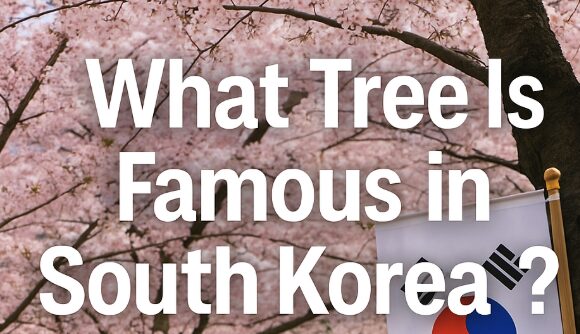When people think of South Korea, they might imagine bustling cities like Seoul or scenic islands like Jeju. But hidden within Korea’s four seasons and mountainous terrain is a rich botanical heritage — and one tree stands out not just in landscapes but also in culture, art, and daily life.
If you’re curious about Korean nature or planning to visit during cherry blossom season, this post introduces the most famous trees in South Korea, what they symbolize, where to see them, and why they matter to Koreans. Whether you’re a nature lover, a photographer, or simply looking to understand Korean culture more deeply, this post will take you through more than just facts — it offers perspective.

The Most Famous Tree in South Korea: The Cherry Blossom Tree (벚나무)
Without a doubt, the cherry blossom tree, known in Korean as beot-kkot namu (벚꽃나무), is the most celebrated tree in South Korea, especially during the spring season.
These trees bloom between late March and early April, depending on the region, and their pale pink and white blossoms symbolize renewal, beauty, and fleeting moments — a reflection of the Korean appreciation for seasonal transitions and impermanence.
Cultural Significance
In Korea, cherry blossoms represent purity and the arrival of spring.
Unlike in Japan, where cherry blossoms have a deeper historical and military association, in Korea they’re more linked to joy, festivals, and new beginnings.
Their brief blooming period — usually less than two weeks — is often viewed as a reminder to appreciate the present.
Best Places to See Cherry Blossoms in Korea
Jinhae Cherry Blossom Festival (Changwon): Korea’s largest blossom festival, featuring rows of trees along railway tracks and streams
Yeouido Park (Seoul): A popular urban blossom-viewing location with over 1,400 cherry trees
Gyeonghwa Station: An old train station in Jinhae where petals fall onto the tracks — a favorite photo spot
Seokchon Lake (Seoul): Cherry blossoms reflect on the water with Lotte World Tower in the background
Gyeongju: Historical backdrops like Bulguksa Temple and tomb parks make this town a poetic blossom-viewing destination
Other Iconic Trees in South Korea Worth Knowing
While cherry blossoms may be the seasonal superstar, Korea is home to several other trees that are equally beloved and culturally meaningful.
1. The Pine Tree (소나무 – Sonamu)
Often referred to as Korea’s “national tree,” the Korean Red Pine is a symbol of integrity, strength, and resilience. Found throughout the mountains of Korea, it is a common sight in traditional paintings and poems.
Symbolism: Evergreen strength, scholarly dignity, and uprightness
Uses: Wood for building hanok (traditional houses), incense, and temple architecture
Where to see: Seoraksan and Jirisan National Parks, temple forests
The red pine often appears alongside cranes and tigers in traditional art, embodying Confucian ideals and loyalty.
2. The Zelkova Tree (느티나무 – Neutinamu)
Zelkova trees are massive, shade-giving trees often found in the center of old Korean villages. In the past, they were gathering spots where elders held community meetings.
Symbolism: Wisdom, community, and protection
Where to see: Hahoe Village in Andong, Jeonju Hanok Village
Some zelkova trees in Korea are over 600 years old and classified as national natural monuments
3. The Ginkgo Tree (은행나무 – Eunhaengnamu)
Famous for its golden fan-shaped leaves in autumn, the ginkgo tree is planted along many boulevards and palace walkways.
Season: Mid-October to early November
Symbolism: Longevity, resilience, and good fortune
Warning: The fallen fruit of the female ginkgo tree smells unpleasant — but the visual beauty more than makes up for it
Where to see: Deoksugung Stone Wall Road, Seoul Forest, Hongcheon Ginkgo Forest
4. The Camellia Tree (동백나무 – Dongbaeknamu)
The camellia tree blooms in winter to early spring, with vibrant red flowers that stand out against the snow or bare trees.
Symbolism: Devotion, quiet strength, and enduring love
Where to see: Jeju Island and Tongyeong are known for camellia forests
Camellia oil is also a traditional Korean beauty product
Trees in Korean Culture and Daily Life
Koreans don’t just admire trees for their beauty — they’re part of daily rituals, literature, and even government conservation programs. Here’s how trees are embedded in Korean life:
Poetry and Calligraphy: Pine trees often appear as symbols of endurance and solitude
Temple Landscapes: Trees are selected for their spiritual harmony and natural symbolism
Seasonal Celebrations: Tree blooming or leaf changes are celebrated with regional festivals
Protected Trees: Some ancient trees are registered as “Natural Monuments” and cared for by the government
The respect for nature is deeply rooted in Korea’s Confucian, Buddhist, and shamanistic traditions — and trees, especially old ones, are often seen as living guardians of time and wisdom.
Where to Experience Korea’s Trees Firsthand
If you want to go beyond photos and festivals, consider visiting:
Korea National Arboretum (Gwangneung Forest) – One of the most diverse tree collections in the country
Jeju Gotjawal Forest – A unique lava forest ecosystem
Hyangilam Hermitage (Yeosu) – Surrounded by camellia trees with ocean views
Jirisan Valley – For old pine trees and serene temple walks
These places offer immersive, nature-based travel that reflects Korea’s deeper environmental consciousness.
South Korea’s Trees Are More Than Just Scenic Backdrops
Whether it’s the fleeting elegance of cherry blossoms, the stoic strength of pine trees, or the communal heart of a village zelkova, Korea’s trees are layered with meaning. They show up in old poetry, modern postcards, and the everyday paths walked by students and grandparents alike.
For travelers, paying attention to Korea’s trees adds another layer of appreciation — one that connects you to the rhythm of Korean seasons and the roots of its culture. The next time you walk under a canopy of blossoms or sit beneath a ginkgo’s golden shade, you’ll know you’re part of something much older and more beautiful than a simple photo stop.